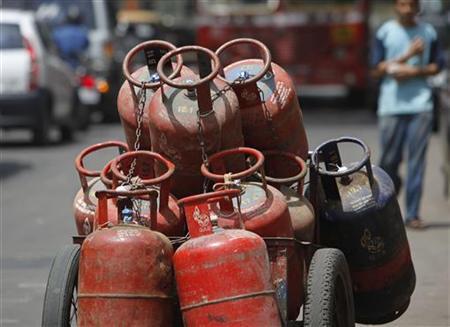
While the Oil Ministry is likely to propose a hike of ₹250 in the domestic LPG, it has encouraged the Indians to follow the path of oil companies' employees, by buying non-subsidised LPG and abandoning the subsidised ones.
The Oil Ministry has come up with two ideas, each proposed to cover up the losses suffered due to subsidised LPG connection.
On the one hand, the ministry has proposed a draft to the Cabinet Committee of Political Affairs to consider a rise in the domestic LPG price by ₹250 and on the other hand, it has appealed the oil companies and its employees to resort to non-subsidised cooking gas.
The steep rise of ₹250 in the LPG has been suggested to cut down the subsidy by ₹72,000 crore, citing that the oil companies have failed to recover losses incurred due to the subsidies. However, the increase in the LPG price will be implemented either by a straight hike of ₹250 or by monthly increase in the price by ₹5-10.
"The ministry will put forward different options for the consideration of the government. The call has to be based on economic and political consideration," The Telegraph quoted a senior Oil Ministry official.
The appeal to quit the subsidised refill was to avail domestic LPG to the households of the rural India, where the people resort to wood, cow dung and coal in the absence of clean cooking gas.
Around 100 employees have already accepted the move willingly and switched to using non-subsidised LPG gas, according to news reports. Chairman of BPCL, S Varadarajan was the first to act upon the request of the ministry. Indian Oil and Bharat Petroleum Corporation Limited (BPCL) have also reportedly started to act upon it.
The petroleum minister Dharmendra Pradhan and the owners of the oil companies believes that this move will help 36 percent of the Indian population who are devoid of clean cooking gas, and hence has motivated the employees to take the initiative.
"Contribute wholeheartedly to the cause of nation-building ... (and) lead the way so that millions follow," The Economic Times quoted Varadarajan.
If the Indian citizens walk on the path of the employees of oil companies and give up the 12 subsidised ones, then each household will have to pay an extra amount of ₹6,200 annually, according to news reports. In case, the hike of ₹250 per cylinder is brought into effect, then the consumers will have to pay a total amount of ₹9,200 annually.
What Price is the Ministry Expecting the Consumers to Pay?
One non-subsidised LPG gas after the hike of ₹16.50 on Tuesday will now cost ₹922.50 in Delhi, ₹966 in Kolkata and ₹949.50 in Chennai.
If the recent proposal to increase the domestic LPG price by ₹250 is accepted, the prices would see a steep rise, which would economically hurt the consumers of Delhi, Kolkata and Chennai as they'll have to pay ₹1,172.50, ₹1,216 and ₹1,199.50 respectively.
And if the Ministry of Petroleum and Natural Gas proposes hike of ₹250, each cylinder will then cost approximately ₹1,500, if CCPA passes the proposal.
Subsidised LPG for Poor & Non-subsidised for Rich?
Many employees of the oil manufacturing and marketing companies have reportedly reacted negatively to the idea. There were suggestions to mandate a policy where the rich and middle classes get to pay for non-subsidised refills while the poor benefits the subsidised LPG gas.
An Indian revenue officer believes that it is difficult to draw a line between rich and poor in India. This division of rich and poor is based on the Basic Exemption Limit (BEL) of income tax. The BEL for one earning member in the family is ₹2,00,000 annually. People with the income above this level are entitled to pay taxes.
This exemption limit does not account for the family size, which is a matter of great attention in India as the number of members varies from three to even seven in a family. It is same with the number of taxpayers in a family. Whereas, one person in the family of five might have to pay the tax alone, some families may have more than one member exempting taxes, according to Hindu Business Line new report.
Without considering the family size, it is difficult to draw a line between the poor and the rich. Hence, it will be unfair to impose the rule to pay the price for non-subsidised LPG on the "rich" just based on the present tax exemption limit.















